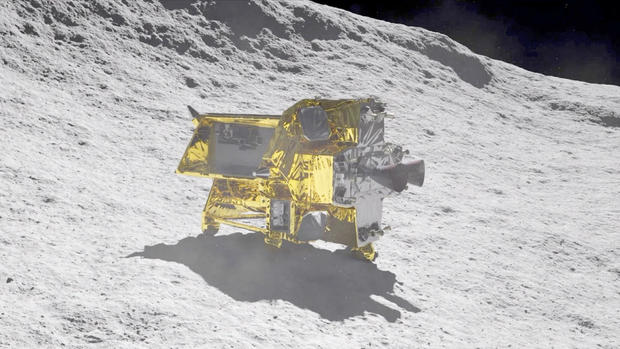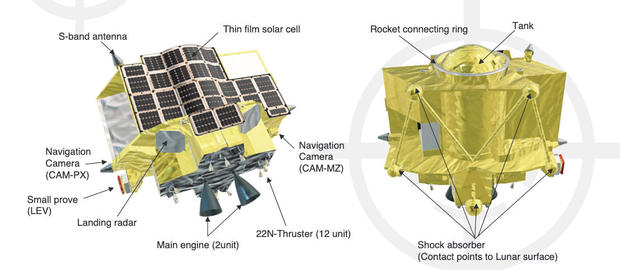Japanese moon lander touches down, but crippled by mission-ending power glitch
A robotic Japanese moon lander touched down on the lunar surface Friday, but it immediately suffered a power glitch of some sort that prevented its solar cells from generating the electricity needed to keep it alive in the harsh lunar environment.
As a result, mission managers said, the otherwise apparently healthy Smart Lander for Investigating the Moon, or SLIM, was expected to exhaust its batteries within hours of touchdown, leaving it powerless and unable to receive commands or transmit telemetry and science data back to Earth.
There's hope the probe could "wake up" at some point, assuming the spacecraft landed in the wrong orientation and the angle between the sun and the solar cells improves enough over time to generate enough power, but officials said that's not at all certain.
"The SLIM has been communicating to the Earth station and it is receiving commands from the Earth accurately and the spacecraft is responding to these in a normal way," Hitoshi Kuninaka, director general of the Japan Aerospace Research Agency, or JAXA, told reporters in translated remarks.
"However, it seems that the solar (cells are) not generating electricity at this point in time. And since we are not able to generate electricity, the operation is being done using batteries. ... We are trying to (get stored data) back to the Earth, and we are making efforts to maximize the scientific (return)."
He said battery power would be exhausted before the day is out.
Only the United States, Russia, China and India have successfully landed spacecraft on the moon. Three privately-financed landing missions have been launched as commercial ventures, but all three failed.
Demise of the Peregrine moon lander
Most recently, the Peregrine lander, built by Pittsburgh-based Astrobotic, was stranded in a highly elliptical Earth orbit after a valve malfunction caused a propellant tank to rupture shortly after launch Jan. 8. Company flight controllers directed the spacecraft to fall back into Earth's atmosphere where it burned up Thursday afternoon.
During a separate news briefing Friday, Astrobotic CEO John Thornton praised company flight controllers for managing to keep the spacecraft alive as long as possible, activating its science payloads, firing thrusters to re-orient the craft and collecting data that will be fed back into the design and operation of a larger moon lander — Griffin — scheduled for launch late this year.
"We're going to be assembling a review board of many experts from across the industry to take a close look at this to figure out exactly what happened," Thornton said. "We are already assessing what those impacts could be for the Griffin program to make sure that this kind of anomaly never happens again."
At the same time, he added, "we also are making sure to incorporate all of the successes of what worked on the Peregrine mission into the Griffin program to make sure that Griffin is successful. ... I am more confident than ever now that our next mission will be successful and land on the surface of the moon."
Japan's plans for a moon landing
JAXA's moon lander was built to achieve two major objectives: to demonstrate a high-precision landing system capable of guiding the probe to touchdown within 100 meters, or about the length of a U.S. football field, of its planned target; and to test an innovative lightweight design allowing smaller spacecraft to carry more sensors and instruments.
Launched on Sept. 7 from the Tanegashima Space Center in southern Japan, the 1,600-pound spacecraft slipped into an initially elliptical orbit around the moon's poles on Christmas Day and transitioned to a circular 373-mile-high orbit earlier this month.
Friday morning U.S. time, the SLIM spacecraft began its final descent to the moon's surface from an altitude of about nine miles. Realtime telemetry showed the vehicle precisely following the planned trajectory, pausing several times along the way to photograph the surface below and compare the view to on-board maps to ensure the expected high-precision landing.
The final stages of the descent appeared to go smoothly. SLIM flipped from a horizontal-to-vertical orientation right on time and slowly dropped toward the surface. It was programmed to release two micro rovers, known as LEV-1 and LEV-2, just a few feet before touching down.
Designed to land on a slope, the probe's two rear legs were expected to touch down first. The spacecraft then was designed to tilt forward slightly, bringing its front legs down. The idea was to position the spacecraft on sloping terrain in an orientation that would maximize solar power generation.
Telemetry indicated a landing at 10:20 a.m. EST, about 20 minutes after the start of the descent. JAXA officials did not immediately confirm receipt of telemetry, raising concern the spacecraft might not have survived touchdown.
But NASA's Deep Space Network, which sends commands and receives data from spacecraft across the solar system, was receiving telemetry from SLIM or one of the tiny rovers -- or both -- an hour after landing.
At the post-landing news conference, JAXA officials confirmed flight controllers were receiving telemetry from both SLIM and LEV-1, which was designed to beam data directly back to Earth. LEV-2 relays data back through SLIM.
"We do consider LEV-1 and LEV-2 to have been successfully separated, and we are making an effort to acquire data at this point in time," said Kuninaka.
As for SLIM, he said engineers doubt the solar cells, mounted on the upper surface of the spacecraft, were damaged in the landing given other systems were working normally after what he described as a "soft" landing.
"The spacecraft was able to send telemetry to us (after landing), which means that most of the equipment on the spacecraft is functional, working appropriately," he said. "Ten kilometers was the altitude from which descent was made. So if the descent wasn't successful, then there would have been a (crash) at a very high speed. Then the spacecraft's function would have been lost completely.
"But now, it is a still sending data properly to us, which means our original objective of soft landing was successful."
But he said extensive data analysis will be required to determine the spacecraft's attitude, or orientation, on the surface, to figure out what happened and to find out how precise the landing actually was.






